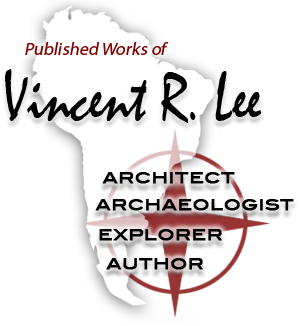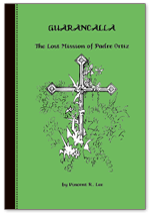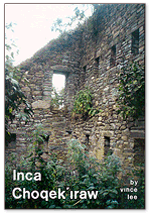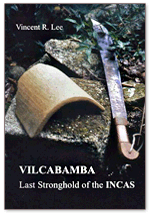PUNCUYOC REVISITED: An Inca Marvel Decoded
The “Incahuasi” (Inca House) is a perfectly preserved example of Inca architecture situated 13,000 ft. high in the Puncuyoc mountains of Peru’s Cordillera Vilcabamba
Puncuyoc Revisited: An Inca Marvel Decoded
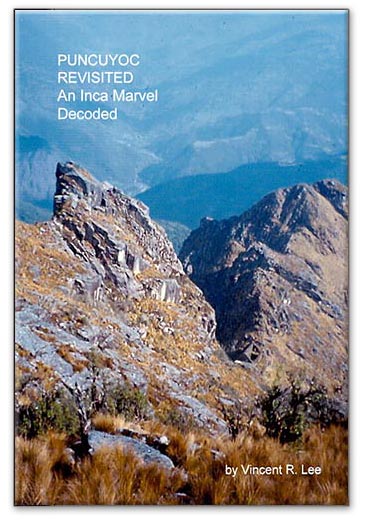
On June 17th, 1984, the author and a group of fellow explorers and Peruvian guides followed an overgrown Inca road into the mists of a spectacular, crag-ringed glacial cirque high in the Puncuyoc Mountains of the remote Cordillera Vilcabamba. They had been searching several days for an elusive ruin reputed to be somewhere up there by veteran explorer Gene Savoy, who had never found the site himself. Suddenly, through a break in the clouds, there it was. A near-perfectly preserved relic from the heyday of the Incas, it was perched astride a 13,000 foot high gap in the surrounding cliffs.
It was the beginning of a 20-year love affair with what the Indians called the “Incahuasi” (Inca House), and a nearby cluster of lesser structures. Various subsequent expeditions by the author and others eventually uncovered an entire complex of associated buildings, platforms, fountains, baths and caves, but to what purpose? The answer remained a mystery until 2003, when a chance pair of discoveries by the author and a colleague, Colorado archaeoastronomer Bernard Bell, changed everything. This is the story of that love affair and the detective work that uncovered the Incas’ reason for creating an architectural gem in such wild and inhospitable surroundings.
This work was also featured in “Puncuyoc, An Inca Aerie in Peru’s Cordillers Vilcabamba” in “The South American Explorer,” No.22, August 1989.
Take a look inside this publication
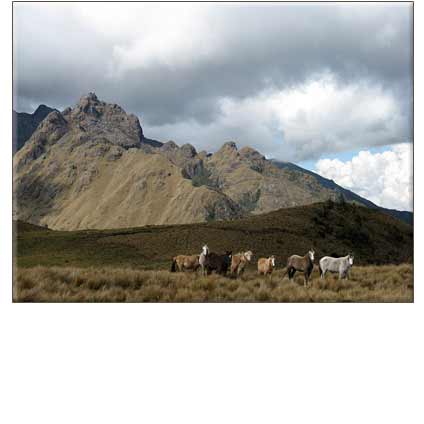 The Incahuasi silhouetted against the far ridgeline in the U-shaped notch to the right of the high peak
The Incahuasi silhouetted against the far ridgeline in the U-shaped notch to the right of the high peak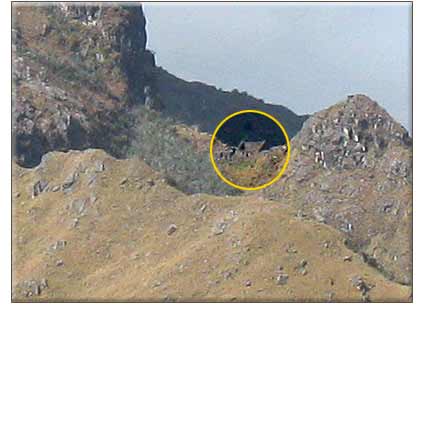 Detail pinpointing the location of the Incahuasi on the ridge
Detail pinpointing the location of the Incahuasi on the ridge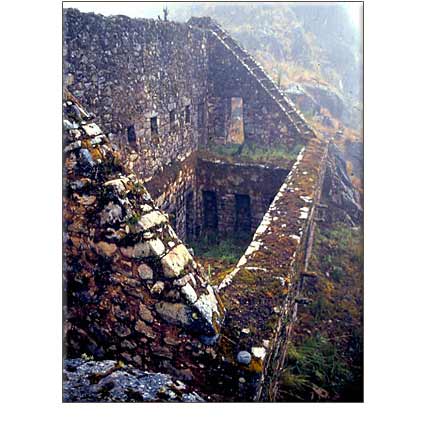 Close up of the Incahuasi ("Inca House") in the Puncuyoc mountains of the Cordillera Vilcabamba in Peru
Close up of the Incahuasi ("Inca House") in the Puncuyoc mountains of the Cordillera Vilcabamba in Peru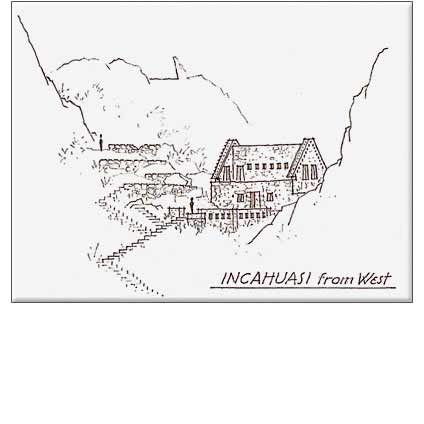 The author's sketch depicting the Incahuasi as situated on the mountain ridge, viewed from the west
The author's sketch depicting the Incahuasi as situated on the mountain ridge, viewed from the west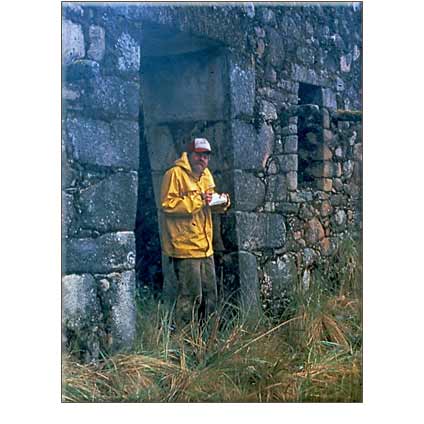 The author in the Incahuasi's west doorway
The author in the Incahuasi's west doorway
Excerpt
Prolog
It was the morning of July 17th, 1984 during Sixpac Manco II, my second exploring expedition into the Incas’ final redoubt, Peru’s Zona de Vilcabamba (Fig. 1). Both excited and exhausted, we trudged up the last of the long series of Inca stairways to re-re-re-rediscover the near-perfectly preserved “Incahuasi” (Inca house) high in the remote Puncuyoc Range of the Cordillera Vilcabamba. It was a heady moment for me and for my companions, a group of neophyte gringos on their first trip to Peru. Imagining ourselves latter day Hiram Binghams, bulldozing back the frontiers of exploration, we were actually the fourth party of outsiders known to have reached the site. Without doubt, the local campesinos had long known of the place as well, but seldom went there if the thick forest cover and pristine state of the “ruins” were any indications. Although we had been told of the site’s existence by veteran Andean explorer Gene Savoy before our trip, he said he regretted never following up on his guides’ reports and going up there himself.
Unknown to us at the time, Puncuyoc had been visited at least six decades before us by the intrepid Swiss explorer, Christian Bües and nearly 31 years earlier by members of Victor von Hagen’s 1954 “Highway of the Sun” expedition. His subsequent book with the same title noted little about the site other than the author’s opinion that the architecture was “Spanish inspired” (von Hagen, 1975, 103-4). Since those early reports, the site had been documented quite thoroughly by Stuart White, who visited the site in the late 1970’s with fellow American explorer, Robert von Kaupp. White’s material remained unpublished, however, until it appeared in the technical journal Ñawpa Pacha, about the time of my second visit to the site in 1986 (White, 1985, 127-160).
I gave a paper describing what was then known of the site to the Institute of Andean Studies at Berkeley in January of 1987 and published a monograph analyzing the architecture of the Incahuasi the following year (Lee, 1988b). In August of 1989, a report of our 1986 expedition was the cover story in South American Explorer #22 (Lee, 1989). Colorado guide Gary Ziegler has more recently led several parties to the site, discovered several previously unreported features in the surrounding terrain and written a brief summary of his finds (Ziegler, 1999). The author, too, has revisited the site numerous times in recent years, often in the company of Colorado archaeoastronomer, Bernard Bell. As a result of these latter-day expeditions, we have a much more complete picture of the site than ever before as well as a better understanding of its purpose and importance. What follows is a complete documentation of this new information together with an abbreviated restatement of earlier insights into the complex and highly significant architecture of the virtually pristine (2004) Incahuasi…….Until the author’s visit with Bernard Bell in 2003, Puncuyoc’s purpose remained a mystery. Then, everything changed.
Bell was intent on investigating astronomical sightlines from the site aided by a table he’d prepared prior to the trip for the latitude of the Incahuasi. The idea was to determine if clear horizon markers could be identified for important dates in the Inca calendar.
Meanwhile, my compadre, Leóncio Chavez, and I conducted a thorough exploration of the cirque east of Puncuyoc, where a heavily overgrown eastern continuation of the access road beyond the Incahuasi suggested additional features might exist. Almost immediately, several terraces and a previously unreported building emerged from the tangled forest (Fig. 9). These, together with two circular ruins, possibly storage structures, below the east terrace indicated that some minor agriculture might have been taken place at the site after all, but it was a modest find.
Continuing across the eastern cirque, we found occasional remnants of the road, but managed to miss a platform reported there years earlier by White (1985, 135 & 145). Bell was to relocate it in 2004 (Fig. 21) and determine that the east road ended there. Not knowing this, Chavez and I explored crags at the head of the eastern cirque on the theory that the east road might lead, eventually, beyond the crest to the long, low-angle south ridge of Cerro Idma, where White had also found a platform (1985, 136 & 143). Although the terrain beyond the crest is rugged and we found no road there, it is passable. It seems likely that this was the route of ascent in Inca times and that the Incahuasi provided a final, overnight rest stop en route to the summit of this apparent “apu,” or sacred peak. Two lichen-encrusted, meter-and-a-half high stone cairns we encountered on the ridge-crest might, we thought, even have been original Inca trail markers (Photo V).
An Astronomical Observatory
Back at the Incahuasi, Bell had finished his calculations and announced that he had found numerous important sightlines. In particular, he showed us approximately where the sun would have risen over the northeastern skyline during the still-observed winter solstice festival of the Inti Raymi. Amazingly, the point he indicated was centered between two tiny skyline bumps we’d not noticed previously. Viewed through binoculars, they were the two cairns Chavez and I had found, clearly silhouetted on the northeastern skyline when viewed from the Incahuasi (Photo W and Fig. 21). Detailed analysis back in the States later confirmed that the 15th century Inti Raymi sunrise occurred precisely between the cairns (Bell, 2004). Quite by accident, we had found an extremely rare surviving example of the once-common Inca practice of marking significant astronomical events with horizon towers as described by Garcilaso de la Vega (1966, Part One, Book 2, Ch. XXII), and various others. At long last, we had found concrete, indisputable evidence of a clear and important purpose for Puncuyoc.

